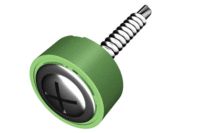Staying current in air sealing is quickly becoming a must for builders in today’s marketplace. Between the expanded adoption of the 2012 International Energy Conservation Code (IECC 2012), new air infiltration program requirements and heightened “green” expectations from homeowners, builders need to incorporate the latest energy efficient solutions to remain competitive.
To help builders address these challenges, the Owens Corning Building Science team conducted extensive air infiltration research to identify the leakage quantities and characteristics of various types of joints and openings in a home. The study uncovered new air sealing insights that today’s builders can use to save time on the job and thus cost-effectively energy efficient homes.
Exceeding Previous Data
During the course of a 12-month period, the Owens Corning Building Science team recorded more than 1,000 individual leakage measurements and ranked them by the amount of air leakage per unit cost to seal each opening. Through this comprehensive air infiltration testing, scientists identified the specific joints and openings in a home where air is most likely to enter and escape through vulnerable gaps, cracks and seams.
Specifically, the study quantified leakage around 17 of the most critical joints and openings in a house. Researches used fan pressurization to measure which leaks have the biggest impact on reducing the blower door number. The findings were then grouped into three categories—those areas that provide a “big bang,” a “medium bang” and only a “small bang” for a builder’s air sealing buck in terms of achieving the best blower door result.
To conduct the research, two forms of blower door testing were employed. One approach tested individual components and wall/ceiling assemblies in a lab setting. A second method tested these same elements in a 1,400-square-foot ranch-style house with basement at Owens Corning’s research facility.
From these testing methods, the study revealed that the five most important areas for builders to focus their air-sealing efforts and dollars are:
- Top plate-to-attic
- Recessed lights
- Duct boots
- Band/rim joists
- Garage-to-house common wall
Budget allowing, next on the air sealing priority list would be:
- Top and bottom plate-to-sheathing
- Bottom plate-to-subfloor
Finally, the study identified the following as areas the least effective areas to seal as they deliver the smallest return on a builder’s investment:
- Corners
- Window and door framing-to-sheathing
- Vertical sheathing joints
- Bottom plate-to-slab
Armed with this knowledge, builders—along with architects and contractors—can review building plans and quickly identify the most effective approach for addressing air leakage and infiltration while still working within budget. When budget permits, all of the gaps and openings in a home enclosure should ideally be sealed in order to properly address the negative effects of air infiltration.
Putting Research Principles into Practice with the Right Products
In addition to understanding where to effectively air seal, builders also need to have insulation and air sealing product solutions that are easy to work with and deliver high-performance results.
Owens Corning’s EnergyComplete Sealant is an exclusive sealant that features a flexible composition designed to expand to easily fill gaps and cracks. The sealant is also the only foamed-in-place air sealing solution that can be applied pre-drywall to create a durable gasket between all top plates making it easy for builders to meet the new IECC 2012 code requirements.
EnergyComplete Sealant also contributes to points of green building programs such as Energy Satar, LEED and the NAHB National Green Building Standard and is GreenGuard Indoor Air Quality Certified. Additionally, it can help save homeowners up to 33 percent on annual heating and cooling costs throughout the life of the home.
Together with the research data, this whole-home insulation and air sealing system from the company will help builders effectively achieve the comfortable, energy efficient homes that homeowners are demanding.
Closing the Gaps of Understanding Air Sealing
Fact: A typical home is built with nearly a mile of joints—presenting a lot of opportunities for air leakage. Yet, even the most informed homeowners today don’t fully understand the correlation air infiltration has on a home’s comfort, durability and energy efficiency. Most would be shocked to learn air leakage accounts for between 25 to 40 percent of the energy used for heating and cooling in a typical residence.
When homeowners are educated on the role air sealing has in both increasing indoor comfort and air quality by preventing dust and airborne pollutants to enter the space, preventing moisture, drafts and unwanted noise from entering their home and saving money on energy costs—it quickly rises to the top of the priority list.
With air sealing growing increasingly top-of-mind, builders can seize this as an opportunity to elevate the discussion around air sealing during the home building process. Armed with the latest industry research and air sealing solutions, builders bring new insights and leverage the new air sealing data as a competitive advantage that distinguishes their business in the marketplace.





